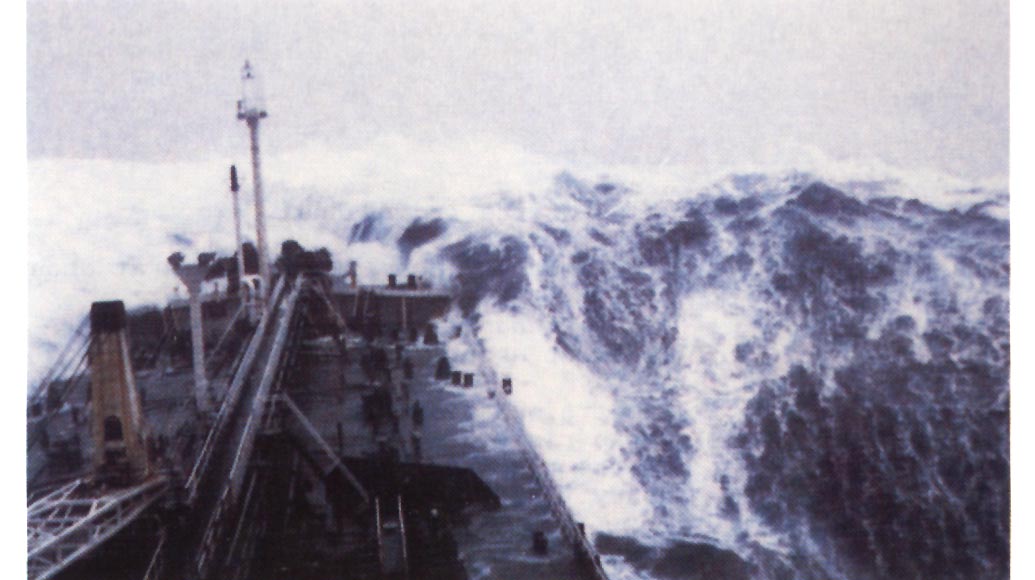So, for your reading pleasure (and so I don't have to write a new post), here it is:
---------------------------------------------------------------------------

At the risk of poaching on Scully’s turf [reference to a deleted blog removed-edited 12/14/07], I want to write about a storm at sea. This took place a long time ago. A group of navy ships from several NATO nations was conducting an exercise in the North Atlantic, off the coast of North Carolina, during the winter. They still called them “task groups” back then, not “battle groups”.
That is not a good place to be at that time of year.
A storm blew up. It was not a light storm. This storm was a very intense low and the meteorologists later said it was an anomaly, a cyclonic low in the winter. The winds during the peak of the storm were measured on some of the ships at over 65 knots. The wave heights were in excess of fifty feet.
What fifty foot waves mean is that if you are on a navy ship smaller than an aircraft carrier, when you are standing in the pilot house and the ship goes down the back side of the wave and it is at the bottom of the trough, you cannot see over the top of the next wave. Then the wave crashes down on your ship and green water charges over the forecastle and up the front of the pilot house, covering the windows. The ship rides up the front of the wave and tilts over it. The bow comes completely out of the water and then slams back into the sea.
Ships with large sonar domes do not ride very well, for the sonar dome does not knife back into the sea. It slams down and the entire ship, all several thousand tons of it, shudders from the impact. Do that enough times and the sonar dome can be damaged.
Then there is the fun of being on a ship that is constantly rolling 40 degrees from side to side. Cooking is impossible, so you had better like cheese and bologna (“cheese and horse cock”)sandwiches, for that is all that there is to eat. And that will be your menu selection for three days, for on the fourth day, they’ve run out of bread.
“Cheese and horse cock, hold the bread.”
After the storm, the sailors have to clean the bulkheads along all of the passageways. Not because people have puked on them, but because they have walked on them. The lower portions of the passageways have footprints. The XO just loves seeing footprints on white bulkheads.
Sleeping is difficult at best. For the sailors on the bottom two racks, they sleep on “coffin racks”; the bunk is a mattress on top of a horizontal locker. The top rack is a mattress on a wire bed frame with springs around the edges. If you’re on a coffin rack, you hopefully have a bungee cord or three to secure yourself in. If you’re in a rack with a wire/spring frame, you sleep face down, for you then slip your arms under the mattress from either side and grab hold of the wire netting under the rack. And yes, you can sleep that way and you can learn to hold yourself in against the rolling of the ship without being thrown out or waking up.
There are things you try not to think about.
One is fuel oil.
Back in the day of oil-fired steam ships, which is to say, almost every navy ship that was not nuclear powered before the mid-1970s, fuel was kept in fuel oil storage tanks. Those tanks almost always had some water in them, because if the tanks were empty in heavy seas, they were ballasted down with seawater. The fuel was pumped to settling tanks, to allow the water to settle out. The water was stripped off, the clean fuel was pumped from the settling tanks to the service tanks, one pair for each boiler, and those service tanks fed the boilers’ burners. It was critical to keep water out of the fuel oil for, as you might suspect, water does not burn very well. At normal steaming rates, a service tank would last twelve hours or more before you had to switch them and refill the empty tank from the settling tanks.
In heavy seas, the settling tanks could not do their job properly, for the fuel would keep being stirred up and the water would not settle out. In really heavy seas, there almost was no point in using the settling tanks at all. You just hoped and prayed that the fuel going to the boilers was not so contaminated that the fires would be lost in the boilers.
For if fires were lost, the ship would go dead in the water, steerageway would be lost and in 50-foot seas, the ship would wind up not heading into the seas, but having them come from her beam. A warship the size of a destroyer or cruiser will not survive heavy beam seas for long, the sea will roll her over. And she, along with her crew, will die.
"Oh Lord, the sea is so vast. and my boat is so small."
Even a warship is a small boat in a Force 12 storm and fifty foot seas.
 And you learn, as people in their twenties should, that sometimes your fate, whether you survive and thrive or die, is not up to you.
And you learn, as people in their twenties should, that sometimes your fate, whether you survive and thrive or die, is not up to you.And you learn, as people should, that what is important to most landsmen really is not all that important. Whether or not your shoes go with your belt. The model of your car. Office politics. Who said what to whom. You learn that sometimes, all you can do is hang on, endure, and hope to survive. For if you do, you may come to know that what a lot of people on shore think is important is really just small stuff.

3 comments:
Wow! Were you on a ship in that storm? Yikes.
EB
I was on a DDG in a storm like that coming back from the North Atlantic. In December. I have pics taken on the bridge of green water going over the bridge. As an IC we maintained the wind anemometers and had displays in our work space. I saw sustained speeds of over 75 knots for hours on end. It was spectacular on the bridge, seeing the force of nature. I believe there were only about 10 of us that did not get sick because that's about all that regularly showed up for meals. I did eat a lot of saltines and drank a lot of tea for the 7 days we were in the storm. We ended up several hundred miles from our destination because we had to go where the sea sent us.
The second photo in the post is from Operation Safepass in 1980. At least three guys from the USS King were swept to their deaths in that storm. I think the photo was taken aboard that ship.
Post a Comment